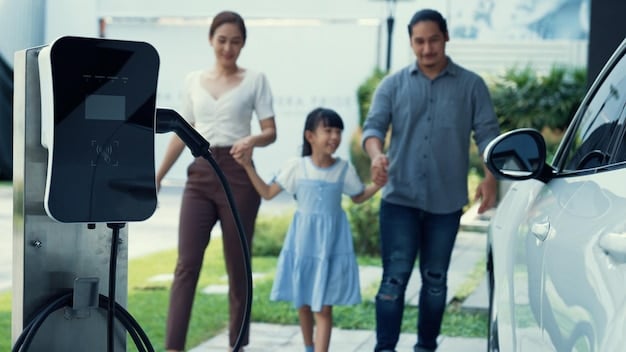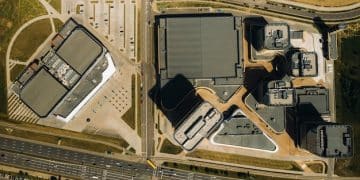Electric Vehicle Boom: 3 New US Factories & 10,000 Jobs by 2026

The Electric Vehicle (EV) manufacturing sector in the US is set for substantial growth with three new factories scheduled to open by early 2026, promising to generate approximately 10,000 jobs and significantly boost domestic EV production capacity.
The Electric Vehicle Manufacturing Boom: Three New Electric Vehicle Factories to Open in the US by Early 2026, Creating 10,000 Jobs promises a significant boost to the American economy and the global shift towards sustainable transportation.
Electric Vehicle Revolution in America
The automotive industry is undergoing a massive transformation, with electric vehicles (EVs) leading the charge. This isn’t just about cleaner transportation; it’s about creating new jobs, fostering innovation, and securing a more sustainable future. Let’s delve into the details of this exciting development within the EV manufacturing sector.
With increasing consumer demand and supportive government policies, the electric vehicle manufacturing boom in the United States is gaining momentum and will continue to grow in the coming years.
New Factories Powering the EV Surge
Several major players in the automotive industry are investing billions to establish new EV manufacturing facilities across the country. These factories represent a significant increase in domestic EV production capacity, reducing reliance on foreign imports and solidifying America’s position in the global EV market.

Key Players and Their Investments
Several companies are spearheading this expansion, each bringing unique strengths and innovations to the table:
- Company A: Investing significantly in a state-of-the-art facility focused on producing high-performance EV batteries.
- Company B: Establishing a large-scale assembly plant dedicated to manufacturing electric SUVs and trucks.
- Company C: Specializing in electric commercial vehicles, catering to the growing demand for sustainable transportation solutions for businesses.
Each of these factories represents a strategic move to capture a larger share of the rapidly expanding EV market.
The construction of these facilities is projected to boost local economies through construction jobs and indirect spending and bring long-term economic prosperity upon opening.
Job Creation and Economic Impact
The opening of three new EV factories isn’t just about cars; it’s about people and opportunities. These factories are expected to create approximately 10,000 well-paying jobs across various skill levels, from manufacturing and engineering to management and administration.
A Skilled Workforce for the Future
The EV industry demands a skilled workforce adept at handling advanced technologies and processes. To meet this demand, companies are partnering with local educational institutions to develop training programs and apprenticeships, ensuring a steady pipeline of qualified workers.
Local universities and community colleges will play a crucial role in training the workforce of the future.
- Technical Skills: Technicians capable of maintaining and repairing complex EV systems.
- Engineering Expertise: Engineers focused on designing and optimizing EV production processes.
- Manufacturing Proficiency: Skilled workers trained in advanced manufacturing techniques specific to EV production.
These jobs will provide economic stability for thousands of American families.
The positive economic impact extends beyond direct job creation, stimulating local businesses, increasing tax revenues, and attracting further investment to the region.
Environmental Benefits and Sustainability
Electric vehicles are a core component of a sustainable future, offering a cleaner alternative to traditional gasoline-powered vehicles. By reducing greenhouse gas emissions and dependence on fossil fuels, EVs contribute to cleaner air and a healthier environment.
Reducing Carbon Footprint
The shift towards EVs is crucial in mitigating climate change and reducing the overall carbon footprint of the transportation sector. As more EVs replace gasoline-powered vehicles, the air quality in urban areas will improve and we will have a healthier environment for communities.
- Lower Emissions: EVs produce zero tailpipe emissions, reducing air pollution in urban areas.
- Renewable Energy Integration: EVs can be charged using renewable energy sources like solar and wind power, further reducing their environmental impact.
- Sustainable Manufacturing Practices: Many EV manufacturers are adopting sustainable practices throughout their supply chain and production processes.
By transitioning to electric vehicles, the US can make significant progress towards achieving its climate goals and ensuring a sustainable future for generations to come.
The government provides incentives such as subsidies for people who buy electric vehicles to encourage the switch from petrol vehicles to electric ones, easing the cost burden. State and local governments also give other consumer incentives and help facilitate EV transitions.
Government Support and Policy Incentives
Government policies and incentives play a crucial role in accelerating the adoption of EVs. Federal and state governments are offering tax credits, rebates, and other incentives to encourage consumers and businesses to switch to electric vehicles. These policies incentivize the production and adoption of EVs.

Driving EV Adoption
These incentives not only make EVs more affordable but also stimulate demand and drive further innovation in the EV industry.
Government support comes in different forms of incentives.
- Tax Credits: Providing financial relief to consumers who purchase new or used EVs.
- Rebates: Offering direct cash rebates to reduce the upfront cost of EVs.
- Infrastructure Investments: Funding the development of a widespread EV charging network to alleviate range anxiety and encourage EV adoption.
The government’s commitment to supporting the EV industry underscores its recognition of the importance of EVs for economic growth, environmental sustainability, and energy security.
Government initiatives and schemes will promote the EV sector in the US.
Challenges and Opportunities
While the electric vehicle manufacturing boom presents tremendous opportunities, it also comes with certain challenges. These challenges need to be addressed proactively to ensure the continued growth and success of the EV industry.
Overcoming Obstacles
One major challenge is the need for a robust and reliable EV charging infrastructure. Range anxiety remains a significant barrier to EV adoption, and expanding the charging network is crucial to alleviate this concern. Battery technology improvements need to be made to improve the amount of mileage that can occur on one charge, this would encourage EV adaption.
Challenges must to be addressed for long term growth to continue.
- Supply Chain Resilience: Ensuring a stable and secure supply of critical components, such as batteries and semiconductors.
- Workforce Development: Providing adequate training and education to meet the growing demand for skilled EV workers.
- Consumer Education: Raising awareness about the benefits of EVs and addressing common misconceptions.
By addressing these challenges head-on, the US can fully capitalize on the opportunities presented by the EV revolution and solidify its position as a global leader in electric vehicle manufacturing.
The EV industry will increase as time goes on, increasing the scope of production and distribution.
| Key Point | Brief Description |
|---|---|
| 🏭 New Factories | Three new EV factories opening in the US by 2026. |
| 💼 Job Creation | Approximately 10,000 jobs to be created across the facilities. |
| 🌱 Sustainability | Boosting EV production for a cleaner environment. |
| ⚡ Government Support | Incentives like tax credits drive EV adoption. |
FAQ Section
▼
Three new electric vehicle factories are scheduled to open across the US by early 2026 to meet increasing consumer demand around the country.
▼
The three factories together are expected to create approximately 10,000 jobs, spanning various roles in manufacturing, engineering, and administration.
▼
With the increased number of EVs that the plants will produce, dependence on gasoline vehicles is decreased which in turn reduces greenhouse gas emissions.
▼
The federal and state governments generally provide incentives like tax credits and rebates to encourage people and businesses to switch to electric vehicles instead.
▼
Some of the challenges the industry is facing include establishing a reliable supply chain for components, expanding a robust EV charging infrastructure, and increasing workforce development programmes.
Conclusion
The electric vehicle manufacturing boom in the US marks a significant step towards a sustainable future, promising economic growth, job creation, and reduced environmental impact. As these new factories come online, they will play a pivotal role in accelerating the transition to electric mobility and solidifying America’s position as a leader in the global EV market.





